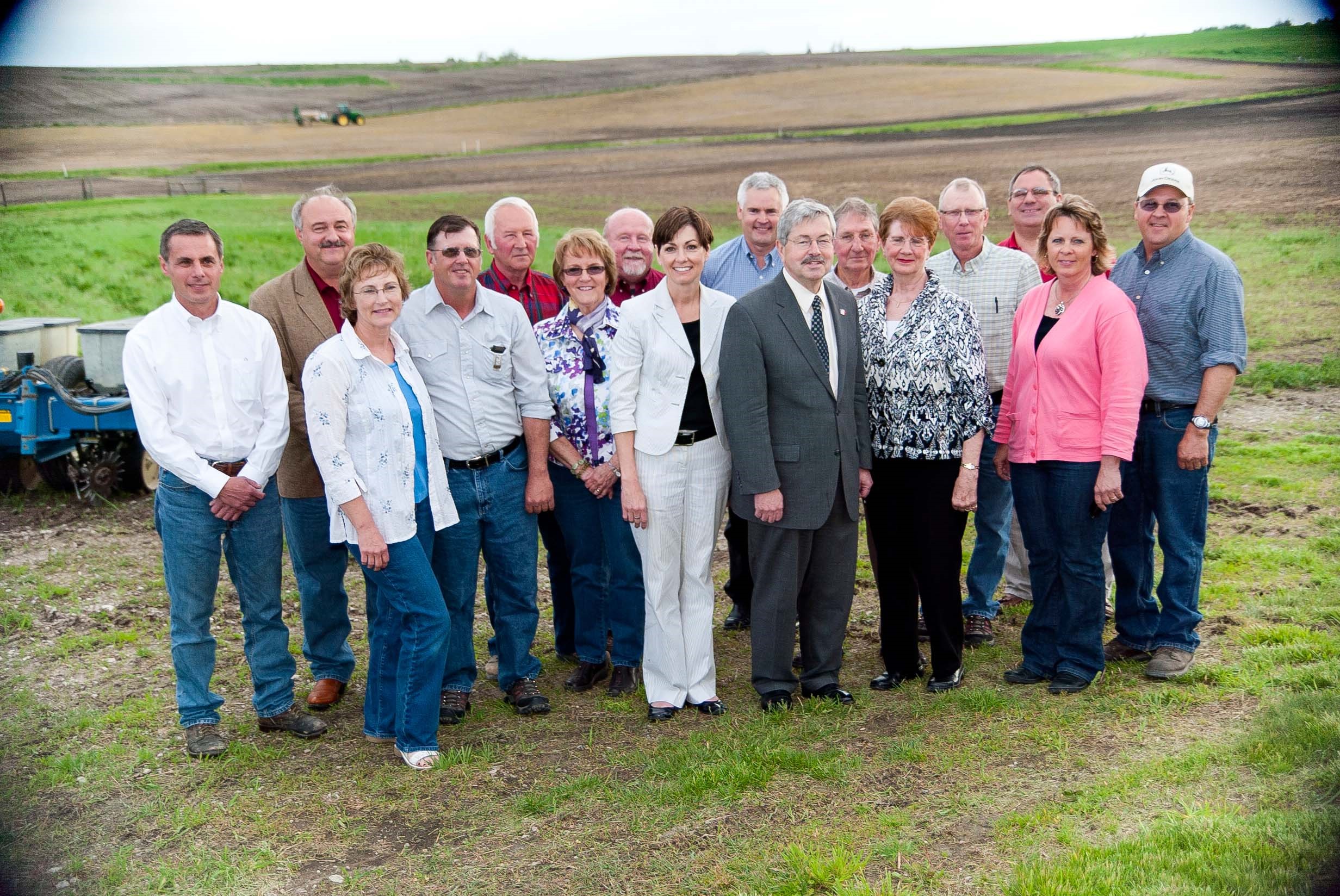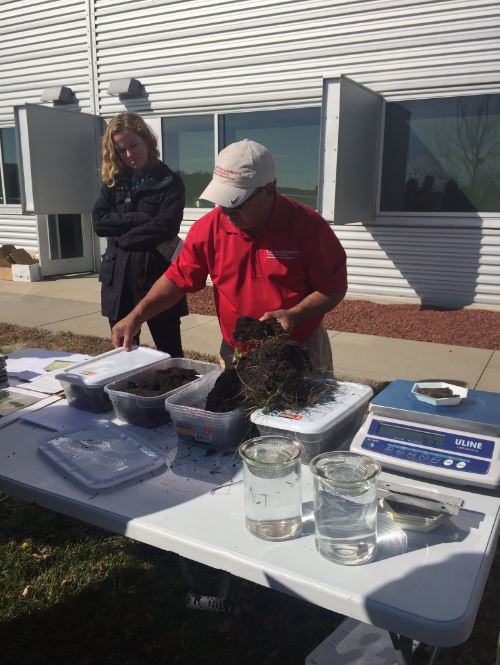The Iowa Watershed Approach (IWA) is a new five-year project focused on addressing factors associated with flood disasters in the state of Iowa. The IWA project will also provide benefits of improved water quality by implementing conservation practices outlined in the Iowa Nutrient Reduction Strategy.
Continue readingGeographic Information Systems at Iowa State University
Big data requires big software and big ideas. This can be especially true when it comes to managing our water-related resources. Today, we have access to numerous data points about our soil and water that can assist in understanding current landscape conditions and to plan for the future. Information such as this is not useful unless it can be analyzed by the experts using software such as Geographic Information Systems (GIS).
Continue readingMonona Demonstrates its Commitment to Water Quality
The permeable parking lot carried a price tag of about $260,000.00. The project would not have been possible without the Water Resource Restoration (Sponsored Projects) Program. The Sponsored Project program allowed Monona to defer a portion of the interest on its sewer project loan, and use those funds for watershed protection practices. The program is a joint effort of the Iowa Department of Natural Resources, the Iowa Finance Authority, and the Iowa Department of Agriculture and Land Stewardship. The permeable roadway project was also supported by the Sponsored Projects program.
Continue readingGet to know the Rathbun Land and Water Alliance
The Rathbun Land and Water Alliance was established in 1997 to promote cooperation between public and private sectors in an effort to protect land and water resources in the Rathbun Lake Watershed. The Rathbun Lake Watershed is located in the six southern Iowa Counties of Appanoose, Clarke, Decatur, Lucas, Monroe, and Wayne and covers 354,000 acres. Rathbun Lake is the primary water source for Rathbun Regional Water Association, which provides drinking water to 80,000 people in southern Iowa and northern Missouri.
Continue readingOut in the Field in the Miller Creek Watershed
Throughout my time in Iowa, I would find myself at a field day or conference looking at a graph showing nitrate levels in water. Before volunteering with the Miller Creek Watershed Project, I saw this kind of graph as a series of data points along an undulating line without a concrete connection to the landscape. I drew conclusions about tillage and other land management practices, about weather, about the planting, growing, and harvest seasons, and how this all relates to water. I did not see how these data points, when taken together, tell a story about what is happening in a watershed.
Continue readingFarmers are Covering Iowa
The Iowa Seed Corn Cover Crops Initiative is a new Iowa Department of Agriculture and Land Stewardship Water Quality Initiative project that will run through 2018. This project is through the Iowa Seed Association in collaboration with the Agribusiness Association of Iowa, the Iowa Farm Bureau Federation, Iowa Corn Growers Association, and the Soil and Water Conservation Society.
Continue reading2016 Fall Watershed Academy
A few weeks ago, approximately 70 Iowa-based water professionals came together for the Watershed Academy. This two-day event was co-organized by Iowa State University Extension & Outreach, Conservation Districts of Iowa, the Soil and Water Conservation Society, Iowa Department of Agriculture and Land Stewardship, and the Natural Resources Conservation Service. The Academy sought to provide the latest information on conservation practices and educational resources.
Continue readingCedar River Watershed Coalition Meeting Recap
On Friday, October 29, I had the good fortune of heading northeast to Parkersburg, Iowa for the Cedar River Watershed Coalition’s Fall 2016 meeting. This group has been convening since February of 2010, and I’ve made it to a few meetings in my time at the Iowa Water Center.
Continue readingWaxing poetic about working together (and NIWR)
In the water world, we talk a lot about working together. We all live in a watershed. The importance of partnerships. Work with your upstream neighbor to improve life downstream.
Sometimes, all it is, is talk. We say we want to work together, but it doesn’t happen, for whatever reason – maybe we can’t get together, we get busy with other things, we can’t agree on priorities. But the reason we talk about working together in water is because we do all live in a watershed. Working with your upstream neighbor DOES improve life downstream. Partnerships aren’t only important, they’re vital to success, and when we work together, impactful things happen.
Last week, 49 of the 54 Water Resources Research Institutes got together for the annual director’s meeting. The Virginia Water Resources Research Center planned the meeting this year (we had the honor last year) and for three days, we worked together.
A few droplets that represent the bigger “working together” stream:
-49 out of 54 WRRIs were in attendance. The meeting was in Washington, DC. The Virgin Islands made it. Alaska made it. Even Guam made it. (Actually, Guam director Shahram Khosrowpanah is a valued member of the NIWR board.) Distance didn’t preclude the Institutes from getting together.
-We heard from federal representatives that told us water resources research is headed toward the funding of collaborative, interdisciplinary research – multifaceted projects that address water resources not just from a technical perspective but also from a human dimension perspective. Water resources management IS the proverbial Big Picture. Research will treat it as such.
-Over a period of 24 hours, the Iowa, Illinois, and Tennessee Institutes went from chatting over a few sandwiches about potentially working on a regional effort to planning, identifying, and putting into action a plan to work with USGS Water Science Centers in our state and region to focus on making a difference in the Mississippi River basin. (More on that as it develops.) All three states have different priorities and run their Institutes a little differently, but we all have one goal.
This meeting was, and always is, a short period of time in which we focus on what it means to work together. Iowans, you have an opportunity to do the same thing next month at the Iowa Water Conference. Use the conference to not only learn about the latest in water management in Iowa, but to find people and organizations with whom you can work together. Work with your upstream neighbor; you WILL improve downstream. Partnerships ARE important. And for goodness sake, we all live in a watershed!
The First [Business] Day of Christmas: Day One Plenaries
On the first [business] day of Christmas, the Iowa Water Center gave to me…descriptions for Wednesday’s plenaries.
The following plenary sessions will be presented on March 23, 2016 at the Iowa Water Conference in Ames. Registration for the conference will open in January.
Water Quality in Iowa: What Does the Public Think?
Mary Losch, Professor & Director, Dept of Psychology & Center for Social & Behavioral Research, University of Northern Iowa
Issues of water quality are central to both the physical and the economic well-being of communities and states. Understanding the public’s knowledge of water quality and values placed on various dimensions of water quality is crucial to designing strategies to support evidence-informed decision-making about the issue. This presentation will describe a large statewide quantitative survey designed and conducted by the Center for Social and Behavioral Research at the University of Northern Iowa for the Iowa Department of Natural Resources. Beginning in February and concluding in early June 2015, more than 2000 adult Iowans were interviewed via telephone (both landline and cell phones) about their knowledge of and attitudes about water quality in the state. Computer-assisted telephone interviewing (CATI) was used to collect data from a sample of adults in Iowa identified through random-digit dialing (RDD). Interview questions addressed 1) environmental literacy and general views on the environment; 2) understanding of water quality and causes of water pollution; 3) participation in recreational activities and/or employment involving water; 4) positive and negative environmental behaviors that could impact water quality; 5) views about and awareness of strategies for improving water quality; 6) perceptions of responsibility for improving water quality and willingness to pay (WTP) or invest in water quality improvement; and, 7) factors (e.g., demographic, sense of place, information sources) that could impact the knowledge, attitudes and perceptions assessed. Key findings from the survey will be presented and discussed.
———————–
Zero Discharge City: Is this Real?
Brett Emmons, Sr. Water Resources Engineer, CEO, Emmons & Olivier Resources, EOR
Stormwater management in an over 3,000-acre, hydrologically land locked area in the City of Inver Grove Heights, MN became an obstacle for the community’s growth. The traditional stormwater management approach proved to be cost prohibitive. Driven by cost and impact concerns to the surrounding Marcott Lakes and Mississippi River, the City explored a new approach of strict, zero stormwater runoff discharge policy for all development in the area.
The paradigm shift from the traditional ‘pipe-and-pump’ to an enhanced low impact development (LID) approach was recognized as a new national trend with a 2015 National Excellence in Engineering Award. The enhanced LID-system significantly reduced the area’s initial infrastructure capital cost by $18 million and reduced lifecycle costs. “Argenta Hills”, one of the first developments in the area, proved to be very challenging. It included a large commercial retail and an extensive single family residential development. EOR took advantage of the site’s natural topography by maintaining its regional depressions, mimicking natural hydrology. Infiltration was maximized by strategically locating an extensive “Treatment Train System” of: raingardens, porous pavement areas, pervious paver intersections, vegetated swales, infiltration basins and stormwater harvesting. Not only did this approach reduce cost, it also helped in retaining some of the site’s unique natural characteristics and add amenities.
These new, creative approaches introduced by EOR, generated a new framework and opportunity for the cities to use this first-of-its-kind in the country approach to accomplish water quality and flood control protection.
————————-
Think Outside the Treatment Plant to Improve Your Water Quality and Save Money
Eric Thompson, PE, CFM, Senior Water Resources Engineer, MSA Professional Services, Inc.
The City of Lodi, Wisconsin, received a future phosphorus limit of 0.075 mg/L for its wastewater treatment facility. Costs for upgrading the treatment facility to meet the new limit were compared to the anticipated costs of two new watershed-based compliance approaches called Adaptive Management and Nutrient Trading.
Adaptive Management requires that phosphorus loads in the watershed be reduced to the extent that the receiving stream attains the applicable water quality criterion within 20 years, while enabling the treatment facility to maintain a discharge of 0.5 mg/L phosphorus. Nutrient Trading is similar in that it allows reduction of phosphorus in the watershed. However, it does not require compliance to be measured within the stream. The trade-off for this is that nutrient trades must be made at a ratio higher than 1:1 making nutrient trading a safer, but perhaps more costly alternative.
The City of Lodi has prepared a preliminary assessment of alternatives to meet its future phosphorus limit and Adaptive Management would cost roughly half the cost of upgrading the facility. This presentation discusses the development and implementation of the City’s Adaptive Management Project. Elements included assessment of plant operations, sampling for water quality within the receiving stream, and modeling of urban, rural, and farmstead landscapes to determine phosphorus loads. The project also prioritized alternative management practices to reduce phosphorus in the watershed sufficient to achieve permit requirements for the treatment facility.

